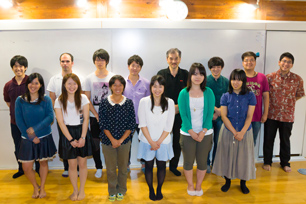Yasushi Ikeda, Professor, Faculty of Environment and Information Studies
Designing sustainable architecture and cities using information technology
A design lies in between abstract conception and specific conflicts. The motto of my lab is to study this through projects that we work in teams.

We research methods of applying information technology to design architecture and cities that harmonize with the environment. In every age, architecture and cities have been created upon request of the society, but today in our life, a sustainable method that enables us to cope with large-scale natural disasters and shortage of energy resources is required on a global scale and perspective. In order to realize this, harmonizing architecture and cities with the natural system rather than to be in conflict with the natural environment is indispensable, and this has also been an ideal form humans have been seeking for since ancient times. It is expected that development of information technology will bring new possibilities in designing such architecture and cities, and the basis of it all is to digitize spatial environment in a three-dimension format.
Starting with BIM (Building Information Model), a method to plan and figure out an architectural design by transmitting and sharing digital design information, there are other methods such as to actually produce and assemble parts and a method to control utilization of spatial environment, and by connecting these methods, various innovative technologies are about to sprout in the process. For example, by reflecting the predictive simulation of spatial environmental factors such as light, heat, airflow and sound, we can create a new form through high-speed calculation that optimizes spatial configuration and steric relationship (algorithmic design), then connect this with the digitally-controlled manufacturing technology (digital fabrication) to realize an idea. Students in my lab learn leading-edge technology of digital designing, and by planning and presenting architectural projects while focusing on harmonizing with the natural environment, they seek possibilities of applying their studies in society. In a project to experiment and verify an eco-house in collaboration with other fields within Keio, we designed a house in which people can live healthily and comfortably using natural energy only, and we are also involved in the construction process. As such, through real experiences of creating things in teams, students learn from each other.
Student’s Voices
Kei Watanabe
Fourth-year student, Faculty of Environment and Information Studies
Computational designing in teams
In our lab, through computerized environmental analysis such as of insolation or wind and through a design method called parametric modeling, we work in teams to study about the process of designing ecological architecture that was never possible in the past. Each member has an area of specialty, such as environmental analysis or computer graphic designing. A new design is created by constantly giving feedback to each other rather than working like on an assembly line. There is always someone staying over in the lab, and also, we sometimes have a barbeque together. Our professor, graduate students, undergraduate students and students from other labs all “live” in harmony.
*Position titles, etc., are those at the time of publishing.
